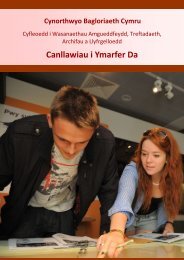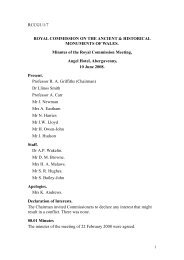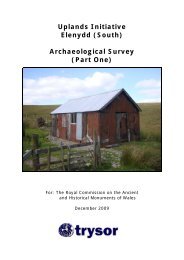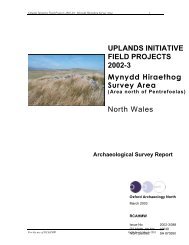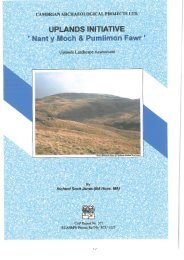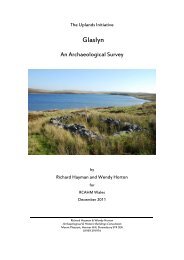Foel Goch Archaeological Survey - Royal Commission on the ...
Foel Goch Archaeological Survey - Royal Commission on the ...
Foel Goch Archaeological Survey - Royal Commission on the ...
Create successful ePaper yourself
Turn your PDF publications into a flip-book with our unique Google optimized e-Paper software.
Uplands Initiative Field Projects 2011-12: <str<strong>on</strong>g>Foel</str<strong>on</strong>g> <str<strong>on</strong>g>Goch</str<strong>on</strong>g> <str<strong>on</strong>g>Survey</str<strong>on</strong>g> Report 18<br />
diameter by up to 0.4m high, and has a central depressi<strong>on</strong> 1m in diameter by 0.3m<br />
deep that is probably from antiquarian disturbance.<br />
5.2.4 The third grouping of m<strong>on</strong>uments c<strong>on</strong>sisted of a pair of round cairns set some 15m<br />
apart <strong>on</strong> a small south-facing plateau <strong>on</strong> <strong>the</strong> ridgeline descending south of Bryn<br />
Bras. The larger cairn (NMR 519261; Plate 11) is a circular kerbed cairn c<strong>on</strong>sisting<br />
of a ring of st<strong>on</strong>es (with a disturbed centre) measuring 11m in diameter by 2-3m<br />
thick and up to 0.6m high. The fabric of <strong>the</strong> cairn is best preserved <strong>on</strong> <strong>the</strong> south-east<br />
side where some of <strong>the</strong> kerb st<strong>on</strong>es survive. At a later period, <strong>the</strong> cairn has been<br />
disturbed to create a fold c<strong>on</strong>taining a small shepherd's shelter and a square external<br />
annex. The smaller cairn (NMR 519260; Plate 12) is 5m in diameter by <strong>on</strong>ly 0.4m<br />
high; it c<strong>on</strong>sists of a small upright st<strong>on</strong>es in places and little o<strong>the</strong>r material in<br />
between. There are four possible kerbing st<strong>on</strong>es <strong>on</strong> <strong>the</strong> south side and a possible<br />
open cist (1m l<strong>on</strong>g by 0.5m wide) is evident in <strong>the</strong> central/east quadrant of <strong>the</strong> cairn.<br />
5.2.5 The fourth grouping of m<strong>on</strong>uments c<strong>on</strong>sisted of three closely associated round<br />
cairns located at <strong>the</strong> summit of Cefn Caer Euni and within <strong>the</strong> later hillfort. The<br />
cairns have apparently not previously been recorded, possibly because a later marker<br />
cairn covers <strong>on</strong>e of <strong>the</strong> cairns, and also because of <strong>the</strong>ir poor survival. All <strong>the</strong> cairns<br />
have been denuded with <strong>on</strong>ly <strong>the</strong>ir foundati<strong>on</strong>s surviving, and <strong>the</strong>y each measure<br />
between 3-4m to 7m in diameter (NMR 519340-519342). One of <strong>the</strong> cairns may<br />
have had part of a cist slab visible <strong>on</strong> <strong>the</strong> surface (NMR 519341).<br />
5.2.6 The final grouping of m<strong>on</strong>uments are two fur<strong>the</strong>r cairns located <strong>on</strong> <strong>the</strong> south-west<br />
half of Cefn Caer Euni (NMR 519327 and 519328). Unlike <strong>the</strong> more prominent<br />
cairns already identified in <strong>the</strong> vicinity, <strong>the</strong>se examples are small turf-covered cairns,<br />
each <strong>on</strong>ly measuring up to 4.5m in diameter.<br />
5.2.7 Groups of barrow and cairn cemeteries have been identified <strong>on</strong> <strong>the</strong> Hiraethog Moors<br />
(OA North 2005b; Silvester 2011), and in <strong>the</strong> Brenig Valley (Lynch 1993), with <strong>the</strong><br />
former area c<strong>on</strong>taining st<strong>on</strong>e rows located above <strong>the</strong> village of Pentrefoelas (Davies<br />
1929; OA North 2003; Silvester 2011) and <strong>the</strong> latter also c<strong>on</strong>taining an abundance<br />
of ritual sites, in particular ring cairns (Lynch 1993; Lynch 2002, 22). Both<br />
regi<strong>on</strong>ally and nati<strong>on</strong>ally ring cairns, where excavated, are typically suggested as<br />
sites of ritual cerem<strong>on</strong>y, and are often found in close proximity to funerary cairns<br />
and cairn cemeteries (Lynch 1993, 145). In <strong>the</strong> general regi<strong>on</strong> (c 7.5km east of <strong>the</strong><br />
study area) a ring cairn was found adjacent to a linear cemetery group of three cairns<br />
at Moel yr Henfaes <strong>on</strong> <strong>the</strong> north-western edge of <strong>the</strong> Berwyn mountains above <strong>the</strong><br />
village of Corwen (OA North 2005a). It is also interesting to note that both pairs of<br />
cairns at Bryn Bras and Cwm Cywen/Craig Wenallt in <strong>the</strong> study area have<br />
intervisibility between <strong>the</strong>mselves and <strong>the</strong> ring cairn and kerb cairn located <strong>on</strong> <strong>the</strong><br />
comm<strong>on</strong> at Caer Euni to <strong>the</strong> immediate south-east of <strong>the</strong> study area (Secti<strong>on</strong> 3.3.1).<br />
5.2.8 Ir<strong>on</strong> Age/Roman: an el<strong>on</strong>gated, irregular enclosed hillfort and a single putative<br />
round house had previously been identified <strong>on</strong> Cefn Caer Euni (NMR 93712 and<br />
519350). N<strong>on</strong>e of <strong>the</strong> 25 possible round houses identified within <strong>the</strong> hillfort interior<br />
could be discerned during <strong>the</strong> present survey. The round house <strong>on</strong> Cefn Caer Euni<br />
c<strong>on</strong>sists of an embanked oval platformed structure measuring 8m l<strong>on</strong>g by 7.5m wide<br />
with a slightly scooped centre and an entrance <strong>on</strong> <strong>the</strong> south-east side. This structure<br />
may be of prehistoric origin. A fur<strong>the</strong>r round house had also been previously<br />
identified located <strong>on</strong> <strong>the</strong> west flank of Moel Emoel (NMR 519305; Plate 4), and<br />
c<strong>on</strong>sists of a turf-covered sub-circular earth and st<strong>on</strong>e-c<strong>on</strong>structed bank, measuring<br />
For <strong>the</strong> use of RCAHMW © OA North: February 2012




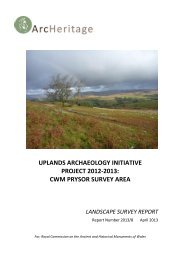
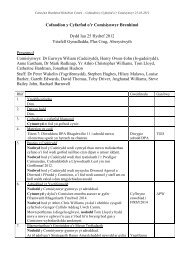
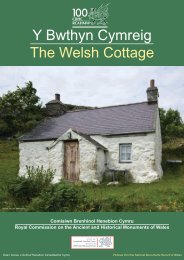

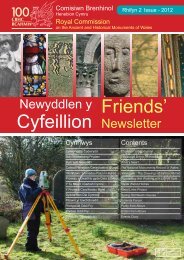
![The Source of the Usk Walk [2012 PDF]](https://img.yumpu.com/49285699/1/190x245/the-source-of-the-usk-walk-2012-pdf.jpg?quality=85)

